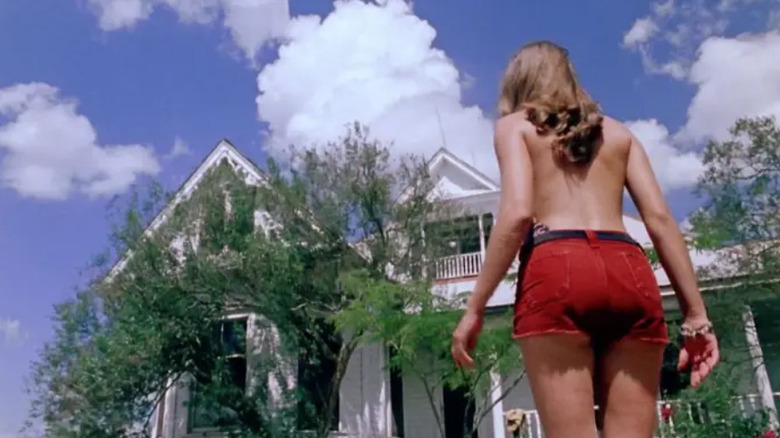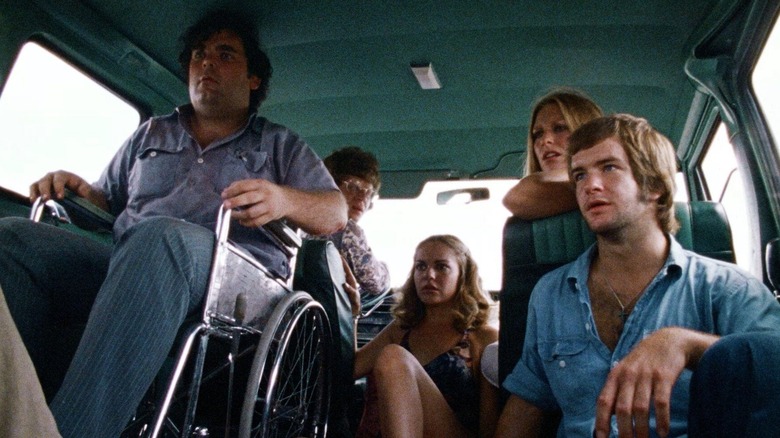The Original Texas Chain Saw Massacre House Will Live On As New Owners Promise To Preserve It
In the conversations about the scariest horror movie moments ever, Tobe Hooper's 1974 classic "The Texas Chain Saw Massacre" tends to land in the top ten, usually for its jarring introduction to slasher icon Leatherface. Beyond the chainsaw and the dysfunctional cannibal family who revere it, the "Texas Chain Saw" franchise has put great stock in its stifling Lone Star state setting, particularly the Sawyer family home which so many victims stumble onto. Filled with real animal bones and shot to the ambient discordance of Hooper and Wayne Bell, the grimy farmhouse was as much an antagonist as its flesh-eating maniacs.
During filming during the summer of 1973, the creepy 1900s house sat on Quick Hill Road in Round Rock, Texas — located at what is now the development site La Frontera. In the late '90s, an investor couple had the entire place deconstructed and re-assembled in Kingsland, Texas, on the grounds of The Antlers Hotel where it now sits. This was only possible because the house is a "pattern book" house; its pattern was picked out of a catalog, and local lumber materials were brought by wagon and assembled on-site.
When the house went up for sale this year, fans were understandably panicking that a piece of cinema history was at risk of being razed to the ground. "Chain Saw" actor Allan Danziger even invited fans to a screening of the 1974 movie on the grounds; "The Last Curtain Call for Chainsaw" happened for fear that no one would ever be able to watch the movie in its original setting again. But the house did sell, and the new owners seem to understand that "the saw is family." According to The Daily Trib, they've pledged to take good care of Leatherface's lair.
Mind the meathooks
The Sawyer house — where Leatherface lives with various family members depending on which sequel you're watching — is one of the few practical horror spots still standing, when so many genre favorites (even Tobe Hooper favorites like "Eaten Alive") were done on soundstages. Some locations are more sought-after than others; few would accompany this writer to see the Paterson, NJ spots where the madness of "Alice, Sweet Alice" was filmed. But those that endure are hallowed destinations for horror heads confronting formative terrors — the steep Georgetown staircase of "The Exorcist" and the Myers house of "Halloween" come to mind.
After its service as a filthy filming location for blade-wielding massacres, the house pulled double duty as a hotel and grub hub as The Antlers Inn and Grand Central Café. The fresh paint and lack of corpses haven't changed its status as a horror haven, as fans still visit for photo opportunities often. In his pre-/Film days when everything on Quick Hill Road was falling to the bulldozer, editor Jacob Hall visited the farmhouse and treated it with the reverence it deserves. He points out that while there aren't animal remains strewn about the premises, its cleanliness can't hide its most infamous nooks and crannies — "there's no mistaking that staircase," he says, the one where Leatherface's first onscreen victim met the business end of a sledgehammer and launched a generation of nightmares.
But fans can rest easy knowing that the unnamed new owners have announced that they are plotting renovations for the beloved farmhouse, and are committed to safeguarding its "history and integrity" with a community space, as a treat.
Finally, some due respect for horror.

